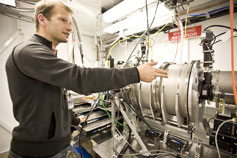
Handy Links
SLAC News Center
SLAC Today
- Subscribe
- Archives: Feb 2006-May 20, 2011
- Archives: May 23, 2011 and later
- Submit Feedback or Story Ideas
- About SLAC Today
SLAC News
Lab News
- Interactions
- Lightsources.org
- ILC NewsLine
- Int'l Science Grid This Week
- Fermilab Today
- Berkeley Lab News
- @brookhaven TODAY
- DOE Pulse
- CERN Courier
- DESY inForm
- US / LHC
SLAC Links
- Emergency
- Safety
- Policy Repository
- Site Entry Form

- Site Maps
- M & O Review
- Computing Status & Calendar
- SLAC Colloquium
- SLACspeak
- SLACspace
- SLAC Logo
- Café Menu
- Flea Market
- Web E-mail
- Marguerite Shuttle
- Discount Commuter Passes
-
Award Reporting Form
- SPIRES
- SciDoc
- Activity Groups
- Library
Stanford
Around the Bay
A Beamline is (Re)Born
For the first time in more than a year, Stanford Synchrotron Radiation Lightsource scientists and users now have access to a fully dedicated small angle X-ray scattering, or SAXS, beamline to study biological molecules. The new Beamline 4, which was moved from a previous location on the SPEAR storage ring and rebuilt from the ground up, also boasts two side stations—branch lines 4-1 and 4-3—for conducting X-ray absorption studies of biological and environmental samples.
SAXS is a technique in which a small amount of protein or virus suspended in solution is exposed to X-rays, which are scattered and picked up by a detector. It's used to study molecular dynamics that cannot be studied when the molecules are in a crystalline form. For example, the technique is useful in exploring how proteins fold. SAXS also is considered complementary to X-ray crystallography, which is used to create a high-resolution—but static—picture of the structure of biological molecules.
The newly updated SAXS station resides in branch line 4-2. Commissioning of this middle and longest section of Beamline 4 finished last week, with the first round of data collection underway now. Senior staff scientist Hiro Tsuruta says the first experiments will take advantage of SAXS's ability to look at biological processes. Tsuruta and colleagues will study how a particular kind of a virus-like particle changes over time, which could yield important clues to how to control the viral infection process.
Branch lines 4-1 and 4-3 are undergoing commissioning now, and will be available to users in early 2009.
—Brad Plummer
SLAC Today, December 3, 2008
